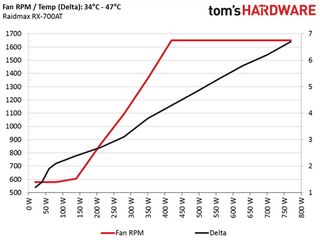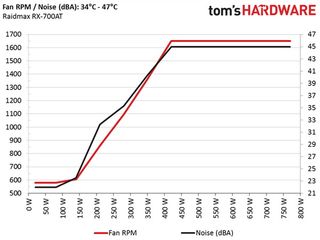Raidmax Monster RX-700AT Power Supply Review
Raidmax is the first company to utilize Andyson's new Titanium platform with its Monster RX-700AT PSU. This is a semi-modular unit with a double ball-bearing fan and Japanese capacitors, promising high performance and exceptional efficiency.
Why you can trust Tom's Hardware
Efficiency, Temperature And Noise
Efficiency
Our efficiency testing procedure is detailed here.
Using the results from the previous page, we plotted a chart showing the RX-700AT's efficiency at low loads, and loads from 10 to 110 percent of the PSU's maximum-rated capacity.




Under normal loads, the RX-700AT easily takes first place, leaving the highly efficient EVGA 650 P2 behind. However, the situation turns under light loads and Raidmax's PSU falls away from the top of the graph. Because this is a Titanium-rated product, we expected it to perform well regardless of load level.
Efficiency At Low Loads
In the following tests, we measure the efficiency of Raidmax's RX-700AT at loads significantly lower than 10 percent of its maximum capacity (the lowest load the 80 PLUS standard measures). The loads we dialed were 20, 40, 60 and 80W. This is important for representing when a PC is idle, with power-saving features turned on.
| Test # | 12V | 5V | 3.3V | 5VSB | DC/AC (Watts) | Efficiency | Fan Speed (RPM) | Fan Noise | PF/AC Volts |
|---|---|---|---|---|---|---|---|---|---|
| 1 | 1.194A | 0.491A | 0.476A | 0.194A | 19.62 | 69.80% | 580 | 22.0 dB(A) | 0.808 |
| 12.196V | 5.069V | 3.339V | 5.066V | 28.11 | 115.1V | ||||
| 2 | 2.418A | 0.978A | 0.986A | 0.391A | 39.72 | 82.75% | 580 | 22.0 dB(A) | 0.875 |
| 12.193V | 5.072V | 3.340V | 5.068V | 48.00 | 115.1V | ||||
| 3 | 3.637A | 1.466A | 1.495A | 5.067A | 59.80 | 87.31% | 580 | 22.0 dB(A) | 0.912 |
| 12.204V | 5.071V | 3.339V | 5.067V | 68.49 | 115.1V | ||||
| 4 | 4.851A | 1.973A | 1.975A | 0.785A | 79.76 | 91.18% | 580 | 22.0 dB(A) | 0.932 |
| 12.202V | 5.070V | 3.338V | 5.064V | 87.48 | 115.1V |
With 20W load, efficiency drops below 70 percent. That significantly affects the average efficiency score under light loads. Our results are much better in the other three tests, with efficiency exceeding 91 percent under 80W of load. In addition, the fan is inaudible.
5VSB Efficiency
The ATX specification states that 5VSB standby supply efficiency should be as high as possible, recommending 50 percent or higher efficiency with 100mA of load, 60 percent or higher with 250mA of load and 70 percent or higher with 1A or more of load.
We will take four measurements: one each at 100, 250 and 1000mA, and one with the full load the 5VSB rail can handle.
| Test # | 5VSB | DC/AC (Watts) | Efficiency | PF/AC Volts |
|---|---|---|---|---|
| 1 | 0.101A | 0.50 | 72.46% | 0.042 |
| 4.992V | 0.69 | 115.1V | ||
| 2 | 0.251A | 1.25 | 77.16% | 0.095 |
| 4.990V | 1.62 | 115.1V | ||
| 3 | 1.002A | 4.99 | 82.21% | 0.265 |
| 4.978V | 6.07 | 115.1V | ||
| 4 | 2.502A | 12.39 | 80.30% | 0.380 |
| 4.952V | 15.43 | 115.1V |


Besides maintaining super tight load regulation, the 5VSB rail is also highly efficient.
Power Consumption In Idle And Standby
In the table below, you'll find the power consumption and voltage values of all rails (except -12V) when the PSU is idle (powered on, but without any load on its rails), and the power consumption when it's in standby mode (without any load, at 5VSB).
| Mode | 12V | 5V | 3.3V | 5VSB | Watts | PF/AC Volts |
|---|---|---|---|---|---|---|
| Idle | 12.219V | 5.066V | 3.339V | 5.066V | 5.48 | 0.299 |
| 115.1V | ||||||
| Standby | 0.07 | 0.004 | ||||
| 115.1V |


Vampire power is very low, and the RX-700AT easily meets the ErP Lot6 2013 directive.
Fan RPM, Delta Temperature And Output Noise
Our mixed noise testing is described in detail here.
The first chart below illustrates the cooling fan's speed (in RPM), and the delta between input and output temperature. The results were obtained at 34 °C (93.2 °F) to 47 °C (116.6 °F) ambient temperature.

The next chart shows the cooling fan's speed (again, in RPM) and output noise. We measured acoustics from one meter away, inside a small, custom-made anechoic chamber with internals completely covered in sound-proofing material (be quiet! Noise Absorber kit). Background noise inside the chamber was below 18 dB(A) during testing, and the results were obtained with the PSU operating at 34 °C (93.2 °F) to 47 °C (116.6 °F) ambient temperature.

The following graph illustrates the fan's output noise over the PSU's entire operating range. The same conditions of the above graph apply to our measurements, though the ambient temperature was between at 28 °C (82.4 °F) to 30 °C (86 °F).

With ambient temperatures under 30 °C, the PSU features silent operation. Up to around 415W load, the fan's noise is close to 22 dB(A) and it takes more than 600W for the noise to exceed 40 dB(A). Under high loads the fan profile could be more relaxed without negatively affecting this unit's reliability.
Current page: Efficiency, Temperature And Noise
Prev Page Load Regulation, Hold-Up Time And Inrush Current Next Page Cross-Load Tests And Infrared ImagesStay on the Cutting Edge
Join the experts who read Tom's Hardware for the inside track on enthusiast PC tech news — and have for over 25 years. We'll send breaking news and in-depth reviews of CPUs, GPUs, AI, maker hardware and more straight to your inbox.
Aris Mpitziopoulos is a Contributing Editor at Tom's Hardware US, covering PSUs.
-
vladm007 You can see the level of faith Raidmax has on the quality by having a 2 years warranty.Reply -
g-unit1111 Reply17870964 said:You can see the level of faith Raidmax has on the quality by having a 2 years warranty.
Yeah that's kind of a deal breaker. :lol: -
turkey3_scratch Another unit cheating on the PWR_OK tests. I'm sick of this crap. Also, those caps on the modular board don't look like Chemi-Con polymers, they look like electrolytics (not that it matters, I'm just questioning if you made a wording error). I also don't like the lack of a thermistor at all. That's some really high inrush current. They could have dished out some cash for one and a relay. I also think the warranty needs increased, but realistically it should last a lot longer than 2 years.Reply -
powernod Reply17871369 said:Another unit cheating on the PWR_OK tests. I'm sick of this crap. Also, those caps on the modular board don't look like Chemi-Con polymers, they look like electrolytics (not that it matters, I'm just questioning if you made a wording error). I also don't like the lack of a thermistor at all. That's some really high inrush current. They could have dished out some cash for one and a relay. I also think the warranty needs increased, but realistically it should last a lot longer than 2 years.
Exactly my thoughts! ;)
Failure at Power_OK signal & huge amount of inrush current = Deal-breaker for me :pfff: -
Aris_Mp if they provide a 5-year warranty and work on the price it has potential. The inrush current is an easy fix with a relay-bypass relay, however the lower than the required hold-up time isn't so easy addressable. A larger bulk cap will need more Amps to charge and more Amps lead to increase power losses, so efficiency will take a hit.Reply -
basroil Very close to be very good, and then it fails at the holdup time... looks like there's still only two real PSU manufacturers (seasonic and superflower)Reply -
Sakkura Why would anyone wonder why Raidmax only has a 2-year warranty? With the junk they've released in the past, it's a miracle they provide any warranty at all.Reply -
g-unit1111 Reply17872208 said:if they provide a 5-year warranty and work on the price it has potential. The inrush current is an easy fix with a relay-bypass relay, however the lower than the required hold-up time isn't so easy addressable. A larger bulk cap will need more Amps to charge and more Amps lead to increase power losses, so efficiency will take a hit.
I think any warranty above 5 years is kind of redundant. In 7 or 10 years you won't have that PSU anyways since you'll be replacing it with something new to keep up with new tech. 5 years I would say is about the length of time a warranty should be. -
turkey3_scratch Reply17872463 said:Very close to be very good, and then it fails at the holdup time... looks like there's still only two real PSU manufacturers (seasonic and superflower)
Superflower cheats on holdup time on various units. Look at the Leadex Gold 550. The 650 G2 also is a problem most likely, and the 750 G2. -
firefoxx04 I've used their cheaper units 3 times. One failed, however, it's environment was a worst case scenario. Very hot Michigan summer with no ac, dusty room, and almost always running the system with 100% cpu and gpu load.Reply